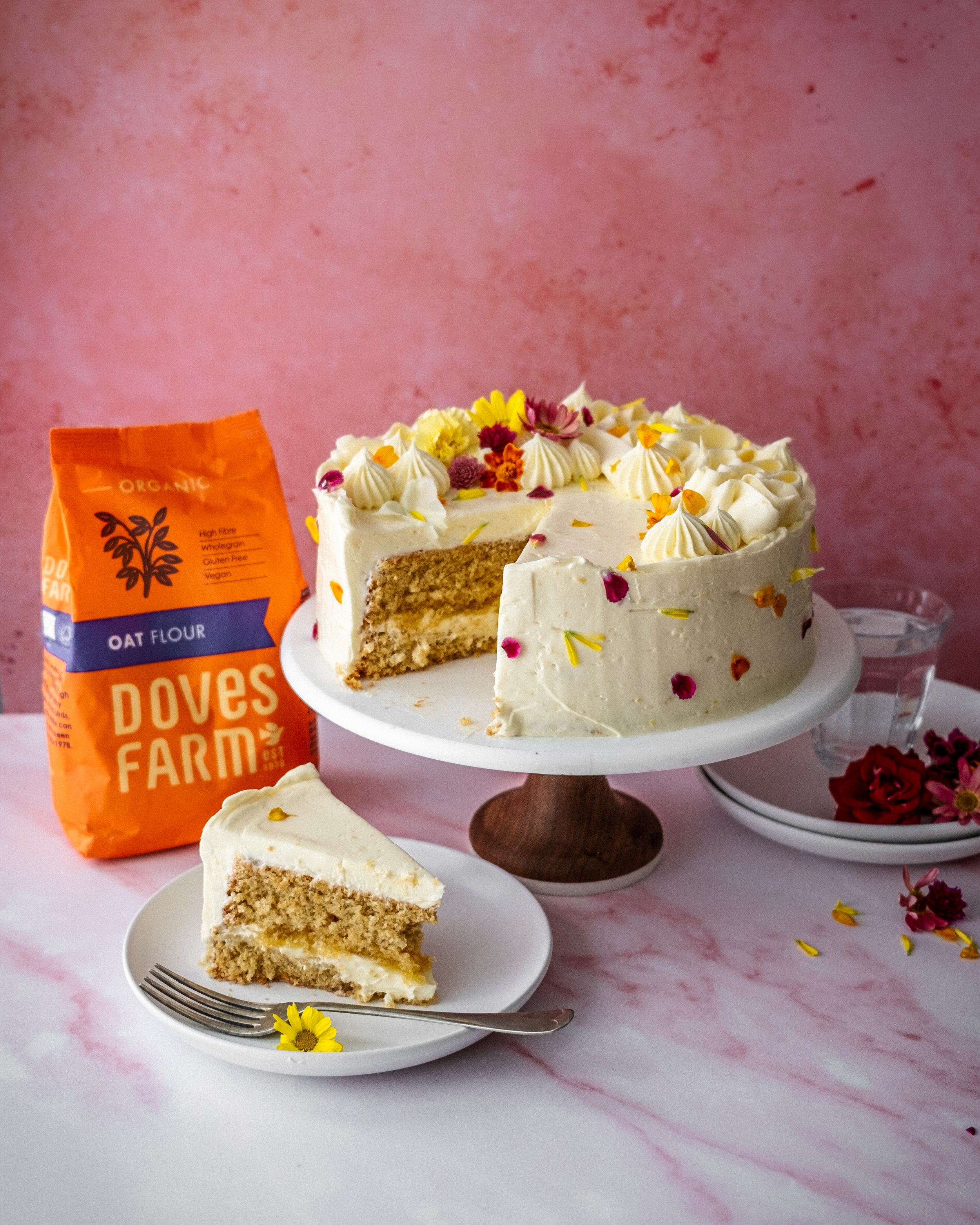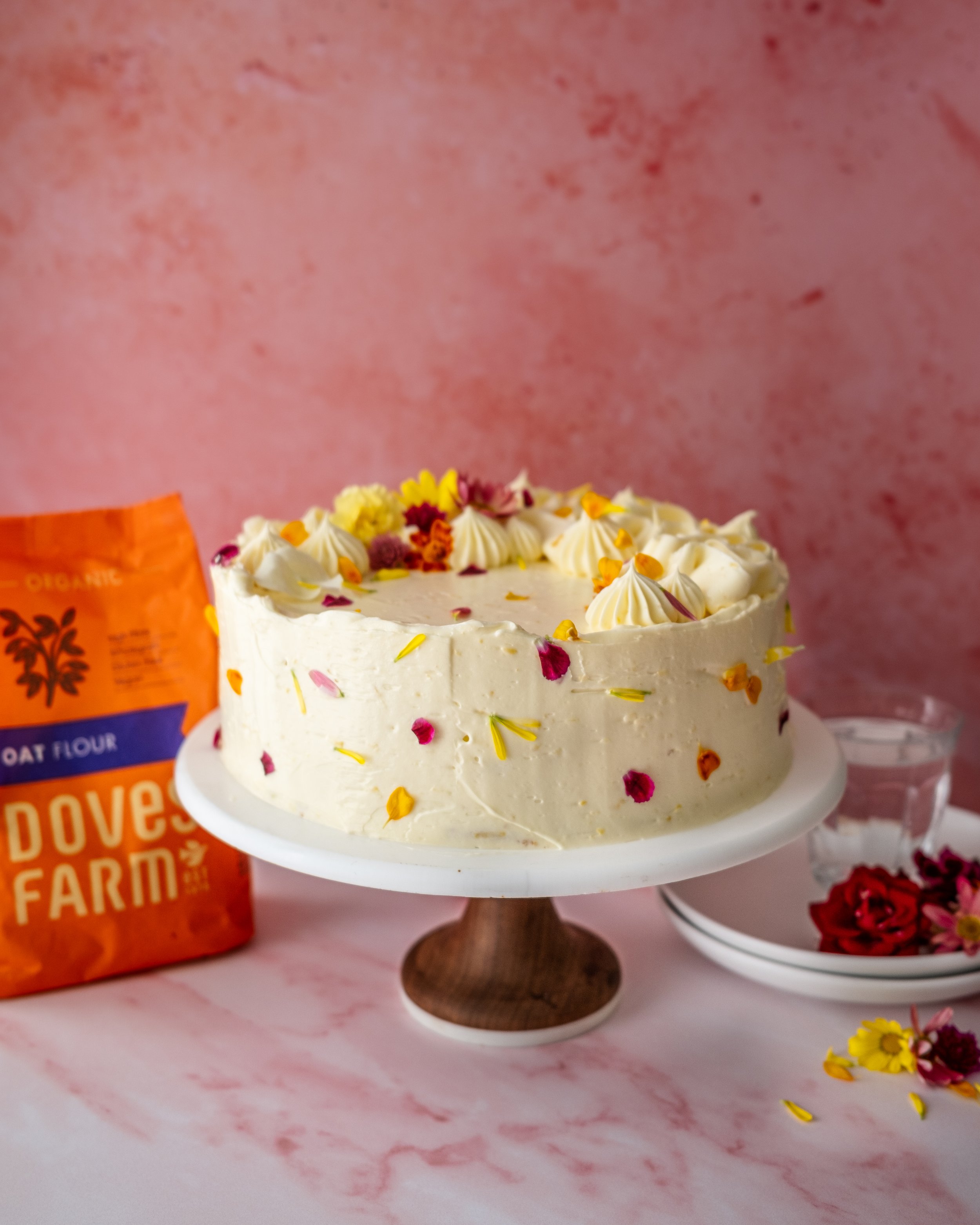Okay, strap in, this recipe has quite a few steps but if you perceiver and work your way through each element, step by step, you’ll be awarded by a batch of twelve stunning eclairs filled with strawberries, lemon and whipped cream. Not only will they be fruity, creamy and utterly delicious they’ll also be beautiful as they’re made with a layer of craquelin coloured to look like the lgbt+ Pride flag, in honour of Pride month.
If you’ve never made eclairs, or you have and they ended up looking a little ugly and misshapen, craquelin might seem like a lot of extra work but trust me, its worth it, the craquelin almost acts as insurance against user error. When choux, made without craquelin, rises in the oven the heat of the oven sets the choux. Sometimes the pastry on the outside will set before the inside is cooked and whilst it still has lots of moisture. This can cause cracking and misshapen choux. When you add a layer of craquelin it slows this process down, the outside of the choux sets slower because the heat of the oven has to get through the craquelin before it can dry out the choux. This means your choux pastry opens up more before it sets. This means better shaped choux and hollow choux, perfect if your making eclairs or really any time of choux bun. The rainbow colours obviously adds to the process and does make it more about intensive but if you make it without colouring, or maybe just with one or two colours, it really is very little extra work and absolutely worth trying.
The lemon cream is a French creation, I believe the original method comes from the famed pastry chef Pierre Herme. A type of lemon curd, Lemon Cream is made in a similar fashion but with two major differences. Firstly the cream has a higher butter content. Secondly, and most importantly, the butter is also added in a different manner. When making a classic lemon curd the butter is either added with all the other ingredients and cooked together or it is added as soon as the lemon custard has been made. Either way this leads to the butter melting into the curd. With this method the curd is cooled down for 15 minutes before the butter is slowly blended into the curd a piece at a time. This results in the butter never melting, instead it is emulsified into the curd and once chilled it becomes incredibly thick and luscious. It is perfect when you want a filling that is thicker than a traditional curd, and something that can hold it shape.
Lemon Cream
150ml lemon juice
zest of 3 lemons
2 large eggs
2 large egg yolks
150g caster sugar
225g unsalted butter, diced and at room temperature
Craquelin
150g unsalted butter, diced and at room temperature
150g caster sugar
150g plain flour
gel food colouring, in rainbow colours
Choux Pastry
70ml water
70ml whole milk
1/2 tsp fine sea salt
1/2 tsp caster sugar
70g unsalted butter, diced
70ml plain flour
2 large eggs
To Fill
250g strawberries, diced
2 tbsp strawberry jam
600ml double cream
1 tsp vanilla bean paste
To make the lemon cream, add the lemon juice, lemon zest, eggs, egg yolks and caster sugar into a heatproof bowl set over a pan of simmering water and cook, stirring regularly until the mixture reaches 80ºC on an instant read thermometer. The temperature is key because it needs to be fully cooked like a custard so the finished cream holds the correct texture. I have said here to do this stage in a bain marie but half of the time I just place the ingredients directly into a saucepan and do this over a low heat stirring constantly. It is quicker than the bain marie method but it is also more prone to catching and overcooking so if you decide to do it this way be very careful and keep the heat down low.
Once the custard is cooked pour it into a large jug, through a fine sieve to remove the lemon zest and any cooked egg bits, allowing to cool for 15 minutes, when it should be 60c or lower. Using some form of blender (traditional jug style or stick blender both work great) blend in the butter a piece at a time. If using a stick blender do this in the jug you cooled the curd, the depth of the jug means you wont end up incorporating too much air which you're trying to avoid (the same reason it is best not to use a food processor). Once all of the butter has been incorporated pour the cream into a container, press a sheet of clingfilm onto the surface of the custard and refrigerate for at least fours hours, until the mixture thickens up.
At this point the cream can be refrigerated for up to 5 days.
To make the craquelin beat the butter in a bowl until soft and creamy. Add the sugar and beat until smooth and combined. Add the flour and mix to form a uniform dough. Divide the craquelin evenly between 6 small bowls. Add a little food colouring to each bowl, mix until the colouring is evenly mixed. When adding the colouring you’ll need to make the colours very vibrant as they will dull somewhat as the craquelin bakes. Place each piece of coloured dough between two sheets of parchment and roll out until about a couple mm thick. Place all of the sheets of craquelin onto a baking tray and freeze. Once the craquelin pieces are frozen remove them from the freezer and working quickly cut each colour into thin strips. On a fresh piece of parchment paper line up the strips in the order of a rainbow, repeating the pattern as many times as you can. Gently roll over the craquelin with a rolling pin to secure all the strips together to form one large piece of rainbow coloured craquelin. Place back into the freezer whilst you prepare the choux pastry.
Preheat the oven to 195ºC (175ºC Fan).
For the choux pastry place the water and milk into a saucepan and mix in the salt and sugar. Place over low/medium heat and cook until the butter has melted. Turn up the heat and bring the liquid to a rolling boil. Remove the pan from the heat and pour in the flour in one go, mixing immediately forming a soft dough. Place the pan back on the heat and cook for 1-2 minutes more until the dough leaves a fine film on the base of the pan. A tip I learnt from pastry chef Francisco Migoya is that you can also check the pastry is ready by checking its temperature. The point of cooking the choux pastry in this manner is to gelatinise the flour. This happens to the flour when the dough hits between 74-79ºC. At this point scrape the dough into a bowl and beat for a few minutes to cool enough that the dough wont cook the eggs.
Add the eggs to a small bowl and whisk together to combine. Pour a little of the eggs into the pastry and beat together until fully combined. It may look a little separated or like cottage cheese but keep beating, it will eventually come together. Repeat adding more of the egg until the dough has a sheen and is silky and smooth. When lifted from the bowl using a wooden spoon or spatula the dough should easily fall from the spoon forming a v-shaped ribbon when it does.
Scrape the pastry into a piping bag fitted with a round French star tip.
Line two large baking trays with parchment paper and on the back of each piece of paper draw six 11cm long lines, spaced well apart. Using these lines as your guide pipe the pastry into 12 eclairs, trying to keep your piping as neat and even as possible. Remove the craquelin from the freezer and cut out twelve 11x2.5cm pieces. Lay these atop the eclairs. Bake the eclairs in the oven for 35 minutes. Turn off the oven, open the oven door briefly to allow any steam to escape before closing the door and allowing the eclair shells to cool down slowly in the oven. This helps dry out the eclairs and prevents them collapsing or going soft too quickly. Cool them in the oven for about 30-60 minutes.
Once cool use a serrated knife to carefully slice off the tops of each eclair.
For the filling stir the strawberry jam through the diced strawberries and scrape the lemon cream into a piping bag with the end snipped off. Divide the strawberry mixture between the twelve eclairs, spreading the strawberries out so there is a thin layer in the bottom of each eclair shell. Pipe a layer of lemon cream atop the strawberries and use an offset spatula to smooth into a flat even layer. Place the cream and vanilla into a large bowl and whisk until the mixture has thickened and just holding the barest of soft peaks. If you overwhisk the mixture here it will likely go grainy when piped. Scrape the cream into a piping bag fitted with a plain round piping tip and pipe four rounds of cream atop each eclair. Finish by placing the tops of the eclair atop the cream.
Once assembled the eclairs should be served the same day but all of the elements (except the strawberries and cream) can be made in advance and refrigerated/frozen for a few days ahead of time.






